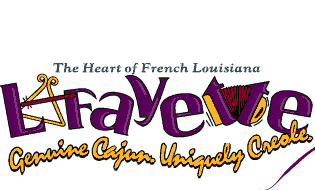 |
Bienvenu! Comment ça va? Welcome to Lafayette, the heart of French Louisiana. If you're looking for a unique cultural experience, then Lafayette is where you want to be. We do things a little different here, cher. |
| The folks here are friendly, the festivals are lively and the cuisine is world-famous. Our unique heritage, a French culture simmering like a gumbo for the past 200 years, makes us seem like another country, only right next door. We call it joie de vivre (joy of life). You'll call it fun! | 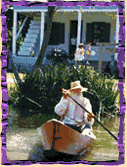 |
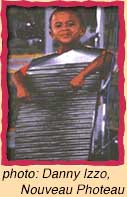 |
When a hot Zydeco band starts cooking, the sizzling backbeat of the frottoir (washboard) makes it hard for your feet to resist the dance floor. Or you may find yourself two-stepping like a native to traditional Cajun fiddle and accordion tunes. |
| Real Cajun and Creole cooking, fresh and spicy, just an oyster throw from the bayou. Festivals and celebrations, from Mardi Gras to a Friday afternoon fais-do-do (street dance). Historic antebellum homes. Lush tropical gardens. Dark, mysterious swamps. Authentic folk life attractions. You'll find it all in Lafayette. So come spend a little time with us here on the bayou. We'll save you a place on the dance floor. |  |
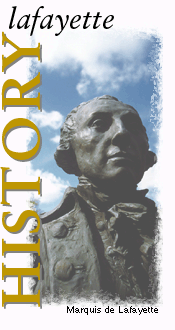 |
Lafayette, the heart of Acadiana and the unofficial capital of Cajun Country, with its gleaming present belies an exciting and captivating past. Lafayette is a metropolis which displays an extraordinary mixture of tradition and progressiveness. Having a rich French heritage blended with Spanish, American, Indian and African influences, the city represents a colorful combination of lifestyles. Lafayette lies 15 miles west of the Atchafalaya Basin and 35 miles north of the Gulf of Mexico and exhibits the subtropical climate typical of South Louisiana. The city is situated in a geographical area of forests and prairies interlaced with bayous, swamps and marshes. |
| Early historians report that a few trappers, traders and ranchers
were present in the region prior to the Spanish occupation of 1766. The
first settlement in south-central Louisiana, known as Petit Manchac, was
established by the English who used it during the Revolutionary War as
an outpost. It constituted a small trading
post on the banks of the Vermilion River where the Old Spanish Trail
crossed the
bayou (about where today's Pinhook Bridge is located). The village also
came to be known as Pin Hook, a name about which many stories of
origin exist. |
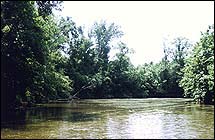 |
 |
The historical event which had the greatest cultural impact
on Lafayette was the migration of the Acadians from French Canada after
"Le Grand Derangement" in 1755. Most of the
exiled Acadians followed the path which led to New Orleans. There they received
a hostile greeting from the French aristocracy so they headed west into
unsettled territory. They settled along the bayous of south central and south
western Louisiana where they could live according to their own beliefs and
customs. With the Louisiana Purchase of 1803, Louisiana then became
possession of the United States. |
| In 1821, Jean Mouton (an Acadian) donated land for the construction of a Catholic church. On May 15, 1822 Bishop Duborg created the church parish of St. John the Evangelist of Vermilion which encompassed the area from Mouton's plantation south to the Gulf of Mexico and west to the Sabine River. |
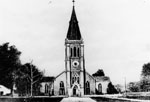 St John's Cathedral 1880 |
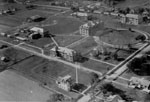 |
The settlement grew around the church and on January 17, 1823, the Louisiana Legislature created Lafayette Parish from the western portion of what was St. Martin Parish. Mouton made a second land donation to the new community, this time for a courthouse. The town of Vermilionville became the new parish's seat. The settlement grew and the town of Vermilionville was renamed Lafayette in 1844 in honor of the French Marquis de Lafayette. |
Year-long attractions include two recreations of early Cajun settlements (Acadian Village and Vermilionville), the Jean Lafitte National Historical Park and Preserve/Acadian Culture Center, the Lafayette Natural History Museum & Planetarium, the Lafayette Museum/Alexandre Mouton House, and numerous fine restaurants. Seasonal attractions include the Azalea Trail in spring, Festival International de la Louisiane in April, La Fête des Acadiens and the Summer Music Festival, both in August, Festivals Acadiens in September, and Christmas on the Bayou and Christmas Comes Alive (the latter at Acadian Village). Lafayette is home to the University of Southwestern Louisiana (enrollment about17,000), which operates the Center for Louisiana Studies, the Acadian and Creole Folklore and Folklife Center, and the Southwestern Archives. The school’s athletic teams are called the "Ragin’ Cajuns" and "Lady Cajuns." Lafayette also boasts professional hockey and soccer teams (the IceGators and the Swamp Cats), both of whom play in the Cajundome civic arena. Lafayette has a population of 108,635 (1995 estimate).
Acadiana
Acadiana (or Cajun Country) is the popular term given to an eight-parish
region.
Lafayette Parish is at the heart of Acadiana and is surrounded by the
remaining seven
parishes: Acadia, Evangeline, Iberia, Saint Landry, Saint Martin, Saint
Mary, and
Vermilion. (Unlike other states, Louisiana has parishes rather than
counties.)
| Louisiana History No other state has a more varied or colorful past than Louisiana. The state has been governed under 10 different flags beginning in 1541 with Hernando de Soto's claim of the region for Spain. La Salle later claimed it for Bourbon France and over the years Louisiana was at one time or another subject to the Union Jack of Great Britain, the Tricolor of Napoleon, the Lone Star flag of the Republic of West Florida and the fifteen stars and stripes of the United States. At the outbreak of the Civil War, Louisiana became an independent republic for six weeks before joining the Confederacy. Earlier, in 1803, Louisiana had become a part of the United States because of the region's importance to the trade and security of the American mid-west. New Orleans and the surrounding territory controlled the mouth of the Mississippi River down which much of the produce of the mid-west traveled to reach market. To get the vital region in American hands, President Thomas Jefferson negotiated the Louisiana Purchase with Napoleon. With the acquisition of Louisiana, Jefferson nearly doubled the size of the fledgling U.S. and made it a world power. Later, 13 states or parts of states were carved out of the Louisiana Purchase territory. (They are as follows: Louisiana, Arkansas, Missouri, Iowa, North Dakota, South Dakota, Nebraska, Kansas, Wyoming, Minnesota, Oklahoma, Colorado and Montana.) Through much of its early history Louisiana was a trading and financial center, and the fertility of its land made it one of the richest regions in America as first indigo then sugar and cotton rose to prominence in world markets. Many Louisiana planters were among the wealthiest men in America. The plantation economy was shattered by the Civil War although the
state continued to be a powerful agricultural region. The discovery of
sulphur in 1869 and oil in 1901, coupled with the rise of forestry sent
the state on a new wave of economic growth. Eventually, Louisiana became
a major American producer of oil and natural gas and a center of
petroleum refining and petrochemicals manufacturing, which it remains to
this day. |
![]() Click to go to Official
Louisiana Website
Click to go to Official
Louisiana Website
Last updated 10/14/06

